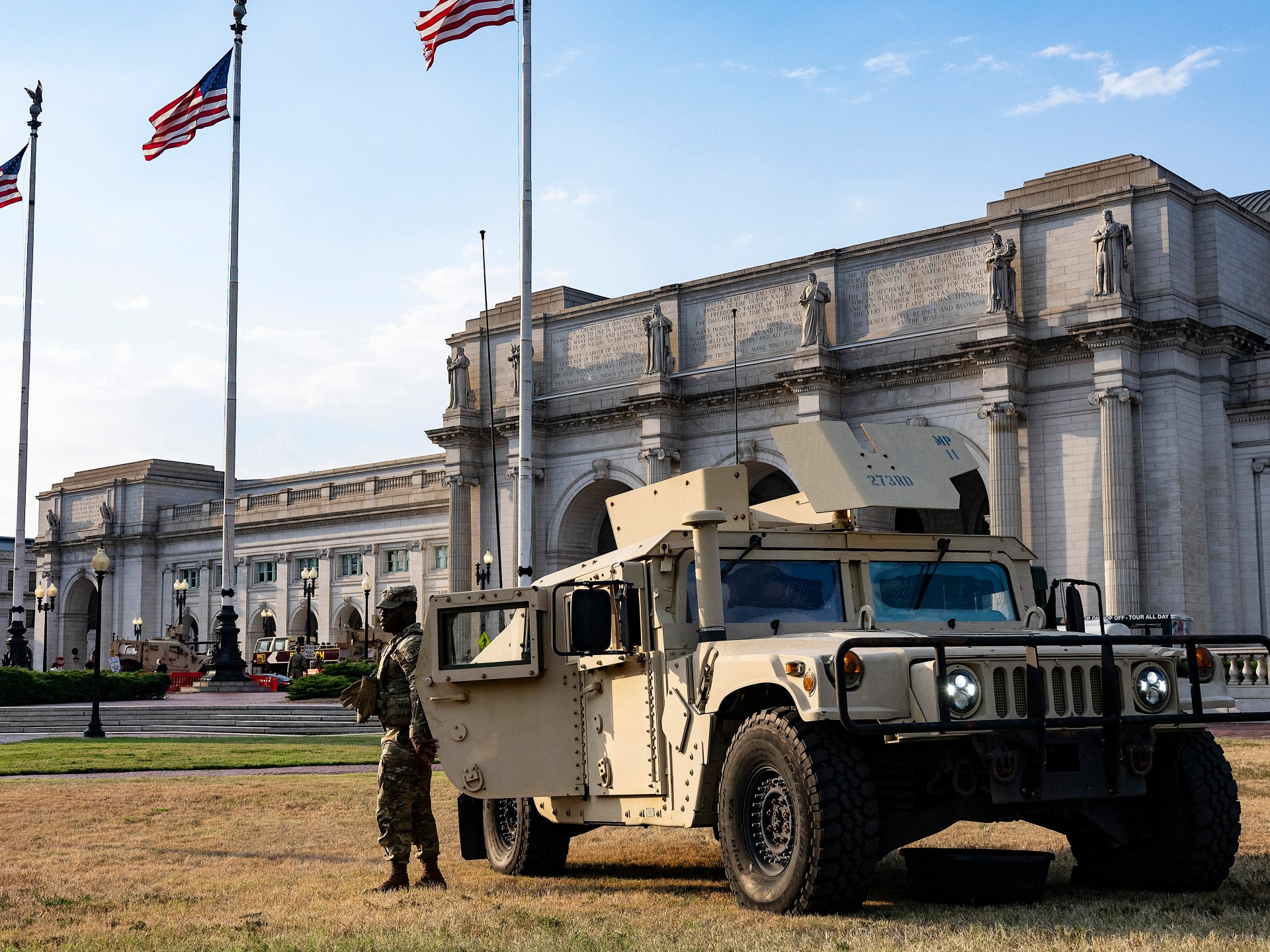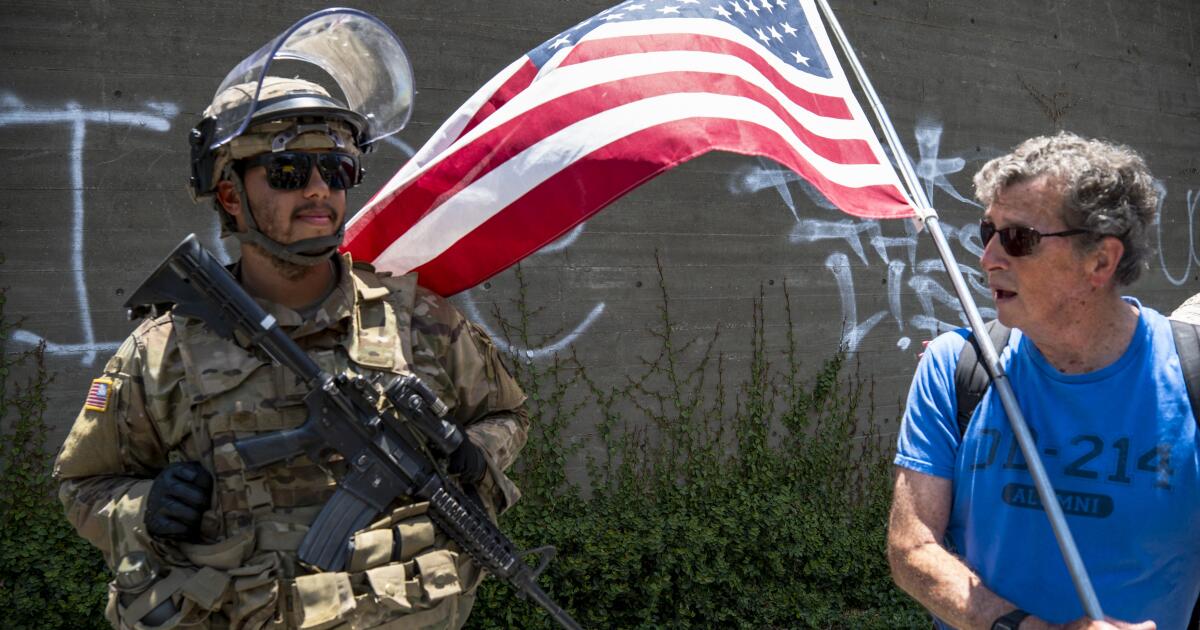Trump’s occupation of DC is a rehearsal for autocracy | Donald Trump
Washington, DC, youth activist Afeni Evans has become the most recent symbol of US President Donald Trump’s federal takeover of the city’s police.
On August 15, Metro Transit Police officers pepper-sprayed and forced the 28-year-old Evans to the ground at the Navy Yard subway stop for allegedly committing fare evasion. Evans and other Harriet’s Wildest Dreams volunteers were at the station on “cop watch” to ensure the federal takeover would not lead to harassment of Black youth. Yet, it happened to three Black youths anyway, prompting Evans to intervene, which led to her arrest.
After public protests in DC and on social media, she was released to cheering crowds outside the court, and the charges against her were dropped the next day.
Like with so many other issues related to Trump and his attempts at autocracy, his use of the National Guard and US Immigration and Customs Enforcement (ICE) to stifle community ecosystems especially impacts Washington’s Black, Brown and Queer residents. This effort to squash potential dissent is more than a distraction from the Epstein files controversy or America’s economic troubles.
Locally, it is a partial end to the District of Columbia’s half-century of home rule, which otherwise makes the city independent of direct federal oversight. Nationally, it is an open question about whether DC can remain a site of protest, a place where marches and other gatherings can effect change or even occur at all in the current autocratic climate.
Trump’s executive order announcing his takeover of DC’s police force on August 11 should not have come as a surprise, especially given his attempts to bring the federal government’s power to bear in California back in June. “Crime is out of control in the District of Columbia”, the order reads, stating that the “increase in violent crime in the heart of our Republic… poses intolerable risks to the vital federal functions that take place in the District of Columbia”.
But the truth is, Trump’s executive order manufactured a crisis out of far-right fantasies. Six days before Trump’s announcement, two teenagers carjacked Edward Coristine, a 19-year-old former staffer at the Department of Government Efficiency, in DC’s Logan Circle. “We’re going to do something about it. That includes bringing in the National Guard,” Trump said in the aftermath of the incident.
However, the two alleged carjackers in police custody were from Hyattsville, Maryland, in Prince George’s County, and not DC.
Trump’s moves also fly in the face of another truth: Crime is no bigger an issue in DC than it is anywhere else in the United States. At the beginning of the year, a joint report from the US Attorney’s Office in DC and the Metropolitan Police Department (MPD) showed that the city’s violent crime rate had dropped by 35 percent in 2024, reaching its lowest rate since the mid-1990s. “Armed carjackings are down 53%,” according to the report.
Washington, DC, is a great stage for beta-testing how willing the rest of the US is to go to achieve Trump’s dream of autocratic rule. DC remains a majority-minority city, with Black Washingtonians making up a plurality (43 percent) of the population, despite 30 years of middle-class (mostly white) gentrification – white Washingtonians make up 39 percent of DC’s population.
So, it is not that surprising Trump would attempt such heavy-handed tactics in a soft occupation of DC, particularly in a city that was once famously nicknamed “Chocolate City”. In a capital where more than 90 percent of voters chose former Vice President Kamala Harris over Trump in the 2024 presidential election, Trump is also sending the unvarnished and racist message that Black folk, and especially Black youth, are criminals.
Imposing a heightened police presence and hundreds of National Guard soldiers on a multiracial city is nothing but a wannabe strongman’s attempt to appear strong to his anti-Black supporters.
DC is also known as a place that holds significance for Queer Americans. One out of every seven adults in the nation’s capital identifies as LGBTQIA+, roughly 80,000 Washingtonians in all. Northwest DC, particularly communities like Dupont Circle, Logan Circle, Adams Morgan, and parts of Shaw and Columbia Heights, became a relatively safe space in the 1960s and 1970s for Queer culture and businesses to thrive. The inaugural National March for Lesbian and Gay Rights began in DC in 1979.
It should not shock anyone that an anti-Queer Trump administration would also target DC’s Queer and migrant spaces. The federalised police presence in DC has been especially noticeable along the 14th Street and U Street corridors, including the installation of not-so-random checkpoints over the past couple of weeks. Inevitably – between the National Guard, federal law enforcement and anti-immigrant agencies like Immigration and Customs Enforcement (ICE), in conjunction with the MPD – they have made dozens of arrests, and smothered nightlife and business traffic in these communities.
Trump, in his own ham-fisted way, is also attempting to erase DC’s history as one of protest and resistance. As the US evolved into a superpower, and DC transformed into the international community’s superpower city during and after World War II, the city also became a place for protest, particularly for racial justice and civil rights. Examples include the March on Washington on August 28, 1963, as well as a series of antiwar protests against Vietnam between 1965 and 1971. Marches and protests for the Equal Rights Amendment, for a Gay Rights Bill, for Chicano rights, Indigenous rights, and migrant and refugee rights came alongside civil rights marches and protests throughout the 1960s and 1970s. Massive protests like the 2017 Women’s March, the George Floyd protests in 2020 and the Free Palestine protests last year have made DC a target ripe for government overreach.
But what Trump is doing to DC in 2025 is not quite unprecedented – not for him, and not for the federal government. In 2018, during Trump’s first term as president, the US National Park Service (NPS) sought to shrink the available sidewalk space around the White House for protests “by 80 percent”, and to charge demonstrators permit fees “to allow the NPS to recover some of the costs” of public safety provisions. On June 1, 2020, the National Guard and the US Park Police tear-gassed, lobbed concussion grenades and violently arrested George Floyd protesters at Lafayette Square, across the street from the White House – all so that Trump could do a photo-op nearby on the steps of St John’s Church, calling himself “your president of law and order” along the way.
Trump has followed in the footsteps of another “law and order” president, Richard Nixon. In May 1971, Nixon unleashed the National Guard and local police against thousands of antiwar demonstrators in DC, in what became known as the Mayday protests, leading to more than 12,000 arrests over a three-day period.
In 1932, President Herbert Hoover authorised the use of military force against a ragtag group of 20,000 unemployed and unhoused World War I veterans known as the Bonus Army. At the height of the Great Depression and looking for the bonus money Congress owed them, the military responded with gas grenades, bayonets, flamethrowers and tanks, destroying their shantytowns along the National Mall and Anacostia River. Two veterans died, while the Army injured thousands of others. The resulting tear gas cloud over the city also led to the death of an infant.
Trump and his small army of occupiers are trying to make an example out of the nation’s capital, to destroy the DC of the past century, its vibrancy and resistance. The irony, of course, is that one of Trump’s first acts in his second term was to pardon more than 1,500 insurrectionists who had been part of the January 6, 2021, attack on the US Capitol, a deadly and treasonous event.
Now, Trump wants to cower Washingtonians into accepting autocracy.
DC’s legacy as the national seat of power, as an international city, and as the centre of the so-called Free World, is in peril. But its most vulnerable and marginalised residents continue to resist, despite the dangers of Trump as a despot.
The views expressed in this article are the author’s own and do not necessarily reflect Al Jazeera’s editorial stance.

